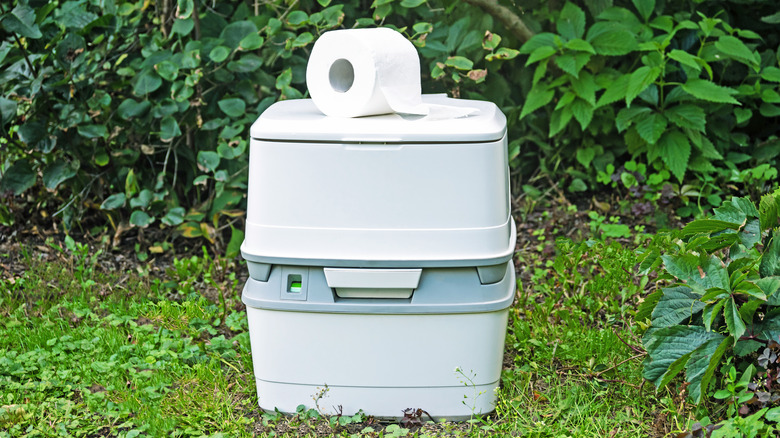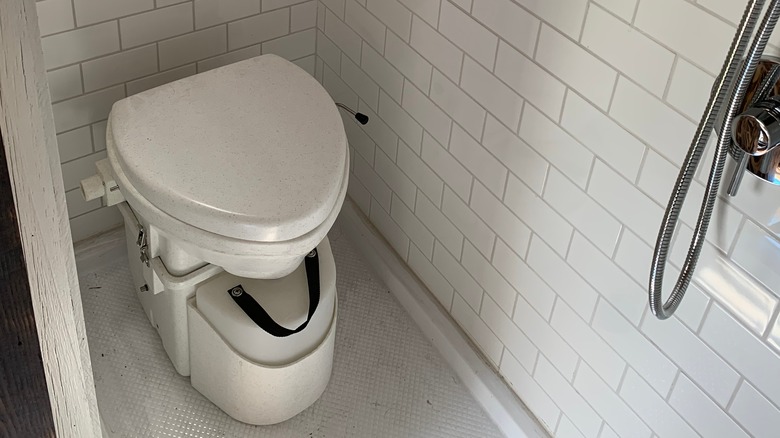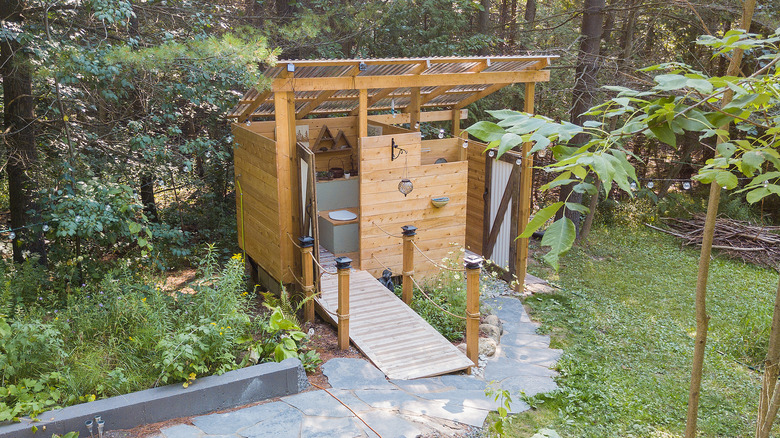Here's How Often You Need To Dump Your Composting Toilet
There are a lot of benefits to using a composting toilet, including the fact that these toilets don't need to be emptied very often. In most cases, you'll need to empty the composting toilet about once a month if you use it within your home, and if it's used infrequently, such as in your weekend cabin, you probably just need to empty it one time a season. If that sounds like a good reason to invest in a composting toilet, don't stop there. It's a fast, easy process that allows you to protect the environment while also making going to the bathroom rather simple no matter where you are.
A composting toilet, which uses the natural decomposition process to break down matter, is very safe to use and simplistic to care for because it happens all on its own. Through decomposition, along with evaporation, the environment helps to break down waste matter over time. The result isn't a sloppy mess but rather a soil-like finished product that's far easier to clean out when the time comes. It's worth learning more about how composting toilets work to reduce water use and cut back on chemical use, even if you don't plan to install one in your home. They can be used in RVs, at camping sites, or even on your boat.
Some factors impact when you need to dump your composting toilet
While the simple rule may be to dump the composting toilet monthly, there are some other factors to think about before doing so. First, consider how frequently you are using it. Those with a larger family may need to do so more often. Also, the chamber size matters since they are available in numerous sizes to fit various spaces. Split composting toilet systems may need less frequent dumping than self-contained models because they hold much more. If your system is smaller because your space is limited, the self-contained model may work best. It's not ideal to allow the material to reach the top before dumping it –- don't use that as a guide for when it should be emptied. You also want to avoid emptying your bin all the way, that way, there is an existing microbiome for its reuse.
Another way to estimate frequency is to consider the number of uses. For example, some systems will hold between 60 to 80 uses, meaning that two people with average needs may need this changed every three weeks for daily use or about two months for just weekend use. Also note that if you use a separate urine bottle, most will require more frequent emptying, generally every three to four days for those holding about 2.2 gallons of fluid.
Other things to consider about composting toilets
A composting toilet should be a very easy system to set up and manage, not requiring a lot of your time as long as it's used properly. In most situations, these toilets should not emit any odor, even though you're not flushing away waste materials like in a water-based, traditional toilet. Rather, the bacteria within the compost should work to break down any scents within a short time, and most often, the waste material is well-contained in a sealed container.
The reason that's important is that you want to have that bacteria present to help with breaking down the material. If you dump the toilet too often, that's going to limit the amount of bacteria present, making it harder for the composting toilet to keep up. Now, if someone were to dump bleach into the toilet, which is never a good thing, that's going to mean you'll need to dump out the entire thing, clean it out, and then start over. Chemicals like this destroy the microbe colony that's growing, and that's going to lead to more odor until that colony builds up again. That's much like an indoor composting bin or one you use for your garden, too.
If you're still unsure about installing a compost toilet and properly maintaining it, turn to the manufacturer's owner's manual. That's going to give you specific care instructions for the make and model you own.


